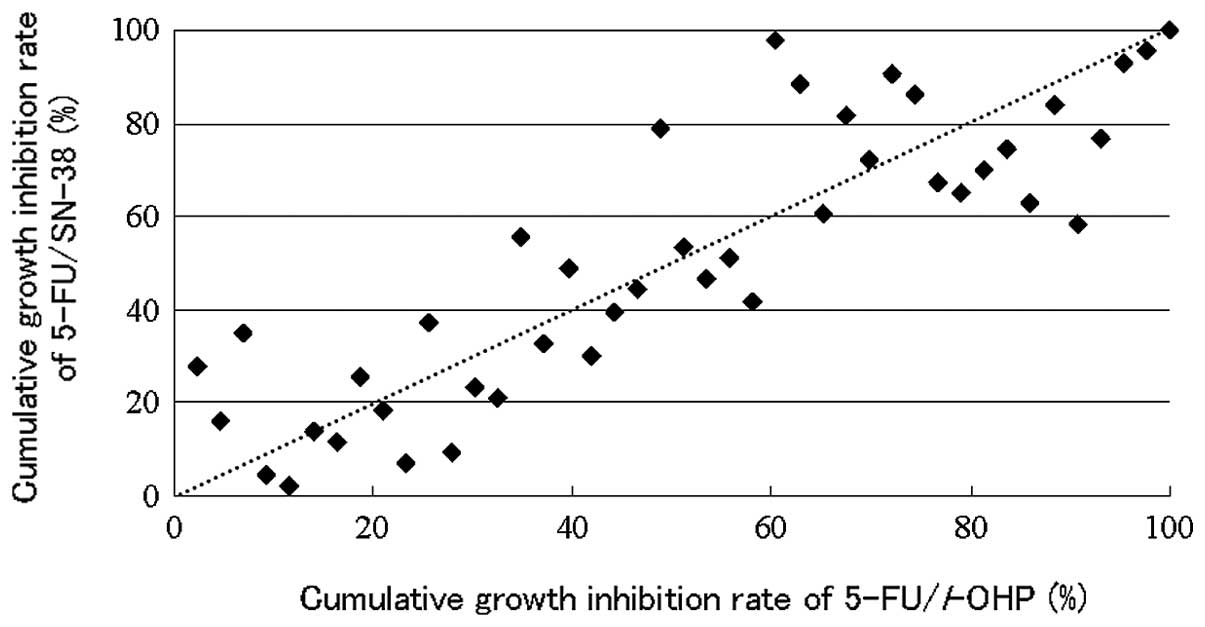|
1.
|
A de GramontA FigerM SeymourLeucovorin and
fluorouracil with or without oxaliplatin as first-line treatment in
advanced colorectal cancerJ Clin Oncol18293829472000
|
|
2.
|
RM GoldbergDJ SargentRF MortonA randomized
controlled trial of fluorouracil plus leucovorin, irinotecan, and
oxaliplatin combinations in patients with previously untreated
metastatic colorectal cancerJ Clin
Oncol222330200410.1200/JCO.2004.09.046
|
|
3.
|
ML RothenbergAM OzaRH BigelowSuperiority
of oxaliplatin and fluorouracil-leucovorin compared with either
therapy alone in patients with progressive colorectal cancer after
irinotecan and fluorouracil-leucovorin: interim results of a phase
III trialJ Clin Oncol2120592069200310.1200/JCO.2003.11.126
|
|
4.
|
JY DouillardD CunninghamAD RothIrinotecan
combined with fluorouracil compared with fluorouracil alone as
first-line treatment for metastatic colorectal cancer: a
multicentre randomized
trialLancet35510411047200010.1016/S0140-6736(00)02034-1
|
|
5.
|
C TournigandT AndréE AchilleFOLFIRI
followed by FOLFOX6 or the reverse sequence in advanced colorectal
cancer: a randomized GERCOR studyJ Clin
Oncol22229237200410.1200/JCO.2004.05.11314657227
|
|
6.
|
HS HochsterLL HartRK RamanathanSafety and
efficacy of oxaliplatin and fluoropyrimidine regimens with or
without bevacizumab as first-line treatment of metastatic
colorectal cancer: results of the TREE StudyJ Clin
Oncol2135233529200810.1200/JCO.2007.15.413818640933
|
|
7.
|
LB SaltzS ClarkeE Díaz-RubioBevacizumab in
combination with oxaliplatin-based chemotherapy as first-line
therapy in metastatic colorectal cancer: a randomized phase III
studyJ Clin Oncol2620132019200810.1200/JCO.2007.14.993018421054
|
|
8.
|
BJ GiantonioPJ CatalanoNJ
MeropolBevacizumab in combination with oxaliplatin, fluorouracil
and leucovorin (FOLFOX4) for previously treated metastatic
colorectal cancer: results from the eastern cooperative oncology
group study E3200J Clin
Oncol2515391544200710.1200/JCO.2006.09.6305
|
|
9.
|
C BokemeyerI BondarenkoA
MakhsonFluorouracil, leucovorin and oxaliplatin with and without
cetuximab in the first-line treatment of metastatic colorectal
cancerJ Clin Oncol27663671200910.1200/JCO.2008.20.839719114683
|
|
10.
|
TS MaughanR AdamsCG SmithIdentification of
potentially responsive subsets when cetuximab is added to
oxaliplatin-fluoropyrimidine chemotherapy (CT) in first-line
advanced colorectal cancer (aCRC)J Clin Oncol28Suppl 5abs.
35022010
|
|
11.
|
CS FuchsJ MarshallE MitchellRandomized,
controlled trial of irinotecan plus infusional, bolus, or oral
fluoropyrimidines in first-line treatment of metastatic colorectal
cancer: results from the BICC-C StudyJ Clin
Oncol2547794786200710.1200/JCO.2007.11.3357
|
|
12.
|
E Van CutsemCH KöhneE HitreCetuximab and
chemotherapy as initial treatment for metastatic colorectal cancerN
Eng J Med36014081417200919339720
|
|
13.
|
A GrotheyD SargentRM GoldbergSurvival of
patients with advanced colorectal cancer improves with the
availability of fluorouracil-leucovorin, irinotecan and oxaliplatin
in the course of treatmentJ Clin
Oncol2212091214200410.1200/JCO.2004.11.03715051767
|
|
14.
|
A GrotheyD SargentOverall survival of
patients with advanced colorectal cancer correlates with
availability of fluorouracil, irinotecan and oxaliplatin regardless
of whether doublet or single-agent therapy is used first lineJ Clin
Oncol2394419442200510.1200/JCO.2005.04.4792
|
|
15.
|
T OchiaiK NishimuraT WatanabeLeucovorin
and fluorouracil plus oxaliplatin or leucovorin and fluorouracil
plus irinotecan as individualized first-line therapy based on a
drug sensitivity testExp Ther
Med1325329201010.3892/etm_0000005022993545
|
|
16.
|
H KobayashiK TanisakaO DoiAn in vitro
chemosensitivity test for solid tumors using collagen gel droplet
embedded culturesInt J Oncol11449455199721528231
|
|
17.
|
H KobayashiM HigashiyamaK
MinamigawaExamination of in vitro chemosensitivity test using
collagen droplet culture method with colorimetric endpoint
quantificationJpn J Cancer
Res92203210200110.1111/j.1349-7006.2001.tb01083.x11223550
|
|
18.
|
E Van CutsemCH KöhneI LángCetuximab plus
irinotecan, fluorouracil and leucovorin as first-line treatment for
metastatic colorectal cancer: updated analysis of overall survival
according to tumor KRAS and BRAF mutation statusJ Clin
Oncol2920112019201121502544
|
|
19.
|
C BokemeyerI BondarenkoJT HartmannEfficacy
according to biomarker status of cetuximab plus FOLFOX-4 as
first-line treatment for metastatic colorectal cancer: the OPUS
studyAnn Oncol2215351546201110.1093/annonc/mdq63221228335
|
|
20.
|
JY DouillardS SienaJ CassidyRandomized,
phase III trial of panitumumab with infusional fluorouracil,
leucovorin, and oxaliplatin (FOLFOX4) versus FOLFOX4 alone as
first-line treatment in patients with previously untreated
metastatic colorectal cancer: the PRIME studyJ Clin
Oncol2846974705201010.1200/JCO.2009.27.4860
|
|
21.
|
M KoopmanS VenderboschH van
TinterenPredictive and prognostic markers for the outcome of
chemotherapy in advanced colorectal cancer, a retrospective
analysis of the phase III randomized CAIRO studyEur J
Cancer4519992006200910.1016/j.ejca.2009.04.01719457654
|
|
22.
|
M KoopmanS VenderboschID NagtegaalJH van
KriekenCJ PuntA review on the use of molecular markers of cytotoxic
therapy for colorectal cancer, what have we learned?Eur J
Cancer4519351949200910.1016/j.ejca.2009.04.02319473832
|
|
23.
|
T OchiaiK NishimuraH NoguchiPrognostic
impact of orotate phosphoribosyl transferase among 5-fluorouracil
metabolic enzymes in resectable colorectal cancers treated by oral
5-fluorouracil-based adjuvant chemotherapyInt J
Cancer11830843088200610.1002/ijc.21779
|
|
24.
|
T OchiaiK NishimuraT WatanabeEvaluation of
the individual 50% inhibitory area under the concentration curve of
5-fluorouracil based on the collagen gel droplet embedded culture
drug sensitivity test in colorectal cancerMol Med
Rep24054092009
|
|
25.
|
T OchiaiK NishimuraT WatanabePersonalized
adjuvant chemotherapy for colorectal cancer (CRC) based on an
individual 50% inhibitory area under the concentration curve (AUC)
using collagen gel droplet embedded culture-drug sensitivity test
(CD-DST)J Clin Oncol28Suppl 15abs. 35822010
|
|
26.
|
MS BraunSD RichmanP QuirkePredictive
biomarkers of chemotherapy efficacy in colorectal cancer: results
from the UK MRC FOCUS trialJ Clin
Oncol2626902698200810.1200/JCO.2007.15.558018509181
|
|
27.
|
H MinamiK SaiM SaekiIrinotecan
pharmacokinetics/pharmacodynamics and UGT1A genetic polymorphisms
in Japanese: roles of UGT1A1*6 and *28Pharmacogenet
Genomics17497504200717558305
|
|
28.
|
Y AndoH SakaM AndoPolymorphisms of
UDP-glucuronosyltransferase gene and irinotecan toxicity: a
pharmacogenetic analysisCancer Res6069216926200011156391
|
|
29.
|
K SaiJ SawadaH MinamiIrinotecan
pharmacogenetics in Japanese cancer patients: roles of UGT1A1 *6
and *28Yakugaku Zasshi1285755842008(In Japanese)
|
|
30.
|
MT SeymourFluorouracil, oxaliplatin and
CPT-11 (irinotecan), use and sequencing (MRC FOCUS): a 2135-patient
randomized trial in advanced colorectal cancer (ACRC)J Clin
Oncol23Suppl 16abs. 35182005
|
|
31.
|
CH KöhneE Van CutsemJ WilsPhase III study
of weekly high-dose infusional fluorouracil plus folinic acid with
or without irinotecan in patients with metastatic colorectal
cancer: European organization for research and treatment of cancer
gastrointestinal group study 40986J Clin Oncol23485648652005
|












